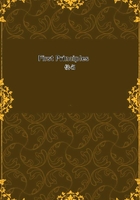
第92章
The Rhythm of Motion §82. When the pennant of a vessel lying becalmed shows the comingbreeze, it does so by gentle undulations which travel from its fixed to itsfree end. Presently the sails begin to flap; and their blows against themast increase in rapidity as the breeze rises. Even when, being fully belliedout, they are in great part steadied by the strain of the yards and cordage,their free edges tremble with each stronger gust. And should there come agale, the jar that is felt on laying hold of the shrouds shows that the riggingvibrates; while the whistle of the wind proves that in it, also, rapid undulationsare generated. Ashore the conflict between the current of air and the thingsit meets results in a like rhythmical action. The leaves all shiver in theblast; each branch oscillates; and every exposed tree sways to and fro. Theblades of grass and dried bents in the meadows, and still better the stalksin the neighbouring corn-fields, exhibit the same rising and falling movements.
Nor do the more stable objects fail to do the like, though in a less manifestfashion; as witness the shudder that may be felt throughout a house duringthe paroxysms of a violent storm. Streams of water produce in opposing objectsthe same general effects as do streams of air. Submerged weeds growing inthe middle of a brook, undulate from end to end. Branches brought down bythe last flood, and left entangled at the bottom where the current is rapid,are thrown into a state of up and down movement that is slow or quick t proportionas they are large or small; and where, as in great rivers like the Mississippi,whole trees are thus held, the name "sawyers," by which they arelocally known, sufficiently describes the rhythm produced in them. Note,again, the effect of the antagonism between the current and its channel.
In shallow places, where the action of the bottom on the water flowing overit is visible, we see a ripple produced -- a series of undulations. If westudy the action and reaction going on between the moving fluid and its banks,we still find the principle illustrated, though in a different way. For inevery rivulet, as in the mapped-out course of every great river, the bendsof the stream from side to side throughout its tortuous course constitutea lateral undulation -- an undulation so inevitable that even an artificially-straightenedchannel is eventually changed into a serpentine one. Kindred phenomena maybe observed when the water is stationary and the solid matter moving. A stickdrawn laterally through the water with much force, proves by the throb whichit communicates to the hand that it is in a state of vibration. Even wherethe moving body is massive, it only requires that great force should be appliedto get a sensible effect of like kind: instance the screw of a screw-steamer[of the primitive type], which instead of a smooth rotation falls into arapid rhythm that sends a tremor through the whole vessel. The sound producedwhen a bow is drawn over a violin-string, shows us vibrations accompanyingthe movement of a solid. In lathes and planing machines, the attempt to takeoff a thick shaving causes a violent jar of the whole apparatus, and theproduction of a series of waves on the iron or wood that is cut. Every boyin scraping his slate-pencil finds it scarcely possible to help making aridged surface. If you roll a ball along the ground or over the ice, thereis always more or less up and down movement -- a movement that is visiblewhile the velocity is considerable, but becomes too small and rapid to beseen by the unaided eye as the velocity diminishes. However smooth the rails,and however perfectly built the carriages, a railway-train inevitably acquiresoscillations, both lateral and vertical. Even where a moving mass is suddenlyarrested by collision, the law is still illustrated; for both the body strikingand the body struck are made to tremble; and trembling is rhythmical movement.